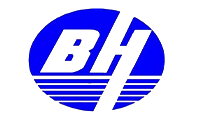Products
-
Q32 Series-Rubber belt tumble type Shot blasting machine
Q32 series -Rubber belt tumble type Shot blasting machine
1. Summary:
- Q32 series Rubber belt tumble type shot blasting machine is suitable for surface cleaning of various parts which doesn’t afraid of collision and easy to roll over.
- All kinds of metal castings surface sand cleaning, black metal parts surface rust removal, stamping parts surface burrs and burrs blunt, forging and heat treatment workpiece surface and spring surface oxide removal and surface grain refinement can be achieved by the series of equipment shot blasting process.
- Its application range is very wide, the main foundry, thermal treatment plant, motor factory, machine tool parts factory, bicycle parts factory, power machine, auto parts, motorcycle parts, non-ferrous metal die casting factory.
- The workpiece after shot blasting can obtain good material color, and it can also become the previous process of the metal parts surface blackening, blue, passivation, etc., and at the same time, it can provide a good base for electroplating, painting and finishing.
- After shot blasting, the tensile stress of the workpiece can be reduced, and the surface grain can be refined, so as to strengthen the surface of the workpiece and increase its service life.
- Rubber belt tumble type (Crawler-type) shot blasting machine has low noise, less dust, high production efficiency, and the shot can be automatically recycled, less material consumption, low cost, which is the ideal surface treatment equipment for modern enterprises.
2. Main structure:
Q32 tumble belt shot blasting machine is mainly composed of shot blasting device, shot blasting chamber, shot sand lifting separation mechanism, dust removal mechanism, electrical control system, etc. High chromium and wear-resistant cast iron are used as lining board in the inner cavity, blade and interior wall of the shot blasting machine to improve the service life.
3. Workpiece principle:- The “Shot sand lifting and separating mechanism” will separate the shot, broken shot and dust to obtain qualified projectiles.
- The shot will enter the high-speed rotating shot parting wheel and rotate together with it by the self-weight shot blasting chute.
- Under the action of centrifugal force, the projectile will enter the directional sleeve and be thrown out in the rectangular window of the directional sleeve to reach the high-speed rotating blade, and the projectile will accelerate from inside to outside on the blade surface. Finally, the workpiece is fan-shaped at a certain linear speed, so that the surface of the workpiece is cleaned by shot blasting.
- When the track in the shot blasting room rotates forward, it drives the workpiece to roll, so that all the workpiece in the shot blasting room and all the surfaces of the workpiece can be cleaned by shot blasting.
- At the same time, the shot sand returns to the lifting separation mechanism, and is recycled after separation, and the workpiece is poured out when the track is reversed.
- The main function of the dust removal mechanism is to participate in the lifting of the separation mechanism of the shot sand separation and the dust generated in the process of dust blasting.
4. Installation:
- When installing, it can be placed on the horizontal concrete floor in the selected position.
- When connecting the power supply, the first line to check the loose fasteners, if found loose should be tightened.
- Switch on the power supply, first test run, check the rotation direction of each motor, such as the reverse phase sequence.
- After the test run, it is determined that all parts are in normal operation, and then it can be put into use.
5. More information, please contact me directly.
Steven Wang
+86-18661870735
Qingdao Binhai Jincheng Foundry Machinery Co., Ltd.,
-
Green (Clay) sand mixer
Green sand mixer
1. Summary:
Green sand mixer is a critical piece of equipment in the foundry industry, used for preparing green sand(molding sand), a type of molding sand that is used to create molds for metal casting. The term “green” refers to the fact that the sand mold is not baked or cured; it is used in its natural, damp state.
2. Components and Operation:
- Mixing Chamber: The main component where the sand, clay, water, and additives are thoroughly mixed to create a uniform moldable material.
- Mixing Blades/Arms: These are the rotating parts within the chamber that churn and blend the materials. They are designed to ensure an even mixture and proper conditioning of the sand.
- Water System: This system adds the precise amount of moisture needed to achieve the desired sand properties. It can include spray nozzles or other water delivery methods.
- Discharge System: Once the molding sand is mixed, it is discharged through a system that delivers it to the molding line or storage.
3. Process: The mixing process involves several key steps:
- Loading: Sand, clay (typically bentonite), water, and any other additives are loaded into the mixer.
- Mixing: The blades or paddles within the mixer rotate, blending the materials until a homogeneous mixture is achieved. The mixing time and blade speed can be adjusted based on the specific requirements of the mold.
- Conditioning: During mixing, the sand is conditioned to have the right moisture content and plasticity, which are crucial for forming strong and stable molds.
- Discharge: The well-mixed molding sand is then discharged from the mixer and transported to the molding area.
4. Applications: Green sand mixers are essential in foundries for:
- Mold Making: Creating sand molds for casting ferrous (iron and steel) and non-ferrous (aluminum, bronze) metals.
5. Advantages:
- Consistency: Ensures uniform mixing of sand, clay, and water, resulting in consistent mold quality.
- Efficiency: Automates the mixing process, reducing labor costs and increasing production speed.
- Adaptability: Can be adjusted for different sand compositions and moisture levels to meet specific casting requirements.
- Quality Control: Advanced mixers with computerized controls offer precise monitoring and adjustments, leading to better control over the properties of the green sand.
6. Selection Considerations:
- Maintenance: Regular maintenance of mixing blades, motors, and control systems is essential to ensure efficient operation and longevity of the mixer.
- Capacity: The mixer should be chosen based on the volume of sand required for the foundry’s production needs.
- Safety: Proper safety measures, including guarding moving parts and providing training for operators, are crucial.
7. Conclusion:
Green sand mixers play a vital role in the foundry industry by ensuring the preparation of high-quality molding sand. Their ability to mix and condition sand efficiently and consistently makes them indispensable for producing reliable and precise metal castings.Steven Wang
+86-18661870735
Qingdao Binhai Jincheng Foundry Machinery Co., Ltd.,
-
Clay(Green) sand production line
Clay (Green) sand casting production line—Automatic molding & Pouring
1. Summary:
- Automatic Clay (green) sand molding pouring line is an advanced manufacturing system used in foundries to produce cast metal parts.
- The process utilizes green sand, which is a mixture of sand, clay, water, and other additives, to create sand molds for metal casting.
2. Components:
- Sand Preparation and Mixing System:
Sand Mixer: This machine mixes sand; clay; water; and other additives to produce green sand. The mixture must have the right consistency and properties for mold making.
Sand Conditioner: Ensures the sand has the correct moisture content and other properties before it is used in the molding process.
- Molding Machine:
Automatic Molding Machine: This equipment automatically compacts the green sand around a pattern to form the mold. The pattern can be made of metal, wood, or other materials and is typically mounted on a molding board or plate.
Pattern Removal: After the sand mold is formed, the pattern is carefully removed, leaving a cavity in the shape of the desired cast part.
- Core Making and Insertion (if needed):
Core Making: For complex shapes, cores made from sand and binders are created and inserted into the mold cavity to form internal passages or features.
Core Setting: These cores are placed into the mold before the two halves of the mold are closed.
- Mold Assembly:
Mold Closing: The mold halves (cope and drag) are assembled together. If there are any cores, they are positioned properly within the mold cavity.
- Pouring System:
Molten Metal Pouring: Molten metal is poured into the mold cavity through a gating system. This is often automated in an automatic line to ensure precise and consistent pouring.
Pouring Machine: An automatic pouring machine can be used to control the flow rate and amount of molten metal poured into each mold.
- Cooling and Solidification:
Cooling Line: The filled molds are allowed to cool and solidify as they move along a conveyor system. Cooling times vary depending on the type of metal and the size of the casting.
- Shakeout and Sand Reclamation:
Shakeout System: After the metal has solidified, the sand mold is broken apart (shaken out) to release the cast part.
Sand Reclamation: The used sand is processed to remove impurities and prepare it for reuse in the molding process.
- Finishing Operations:
Cleaning: The cast parts are cleaned to remove any residual sand and surface imperfections.
Inspection: Parts are inspected for quality and accuracy.
3. Advantages:
- Increased Efficiency: Automation reduces the cycle time for each mold, increasing the production rate.
- Consistency and Precision: Automated systems ensure consistent mold quality and precise control over the pouring process, resulting in higher quality castings.
- Labor Savings: Automation reduces the need for manual labor, lowering labor costs and reducing human error.
- Flexibility: Modern systems can be quickly reconfigured for different casting designs and sizes.
- Improved Working Conditions: Automation minimizes the exposure of workers to high temperatures and other hazardous conditions associated with foundry work.
4. Applications:
- Automatic green sand molding pouring lines are widely used in the automotive industry, machinery manufacturing, and for producing various metal parts such as engine blocks, cylinder heads, and various other complex castings.
In summary, an automatic green sand molding pouring line integrates advanced machinery and automation to streamline the process of creating high-quality metal castings efficiently and consistently.
Steven Wang
+86-18661870735
Qingdao Binhai Jincheng Foundry Machinery Co., Ltd.,
-
No bake Sand molding process
No-Bake Sand Molding Process
Furan Resin Sand Mixer with Sand Storage Tanks,
Phenolic Resin Sand Molding Plant
No-bake is a casting process that involves the use of chemical binders to bond the molding sand. Sand is conveyed to the mold fill station in preparation for filling of the mold. A mixer is used to blend the sand with the chemical binder and catalyst. As the sand exits the mixer, the binder begins the chemical process of hardening. This method of mold filling can be used for each half of the mold (cope and drag). Each mold half is then compacted to form a strong and dense mold.
A rollover is then used to remove the mold half from the pattern box. After the sand has set, a mold wash may be applied. Cores, if required, are set into the drag and the cope is closed over the cores to complete the mold. A series of mold handling cars and conveyors move the mold into position for pouring. Once poured, the mold is allowed to cool before shake-out.
The shake-out process involves breaking the molded sand away from the casting. The casting then proceeds to a casting finishing area for riser removal, casting finishing and finalization. The broken pieces of molded sand are further broken down until the sand is returned to grain size. The sand can now be either reclaimed for reuse in the casting process or removed for disposal. Thermal reclamation is the most efficient, complete method of Nobake sand reclamation.
Steven Wang
+86-18661870735
Qingdao Binhai Jincheng Foundry Machinery Co., Ltd.,
-
Movable Resin sand molding system
MOVABLE RESIN SAND MOLDING SYSTEM
The movable resin sand molding system is a sophisticated manufacturing setup used in the foundry industry for creating molds and cores for metal casting.
This system is highly efficient and versatile, allowing for the production of high-quality castings with complex geometries. Here’s an overview of its components, process, and benefits:
1. Components & acts:
Sand Mixer:
Mixes resin and sand to create the molding material.
Ensures uniform coating of resin on sand particles for optimal binding.
Molding Machine (Swing table):
Shapes the mixed sand into molds using patterns.
Can be automated for precision and repeatability.
Pattern Plates:
Used to shape the sand mold.
Can be easily changed to produce different mold designs.
Curing System:
Cures the resin in the molding sand to harden the mold.
Can use catalysts, or other curing methods depending on the resin type.
Movable Carriage or Conveyor:
Transports the molds through different stages of the molding process.
Enhances flexibility and reduces manual handling.
Mold Handling Equipment:
Includes lifting devices, conveyors, and robotic arms for moving molds.
Increases efficiency and safety in mold handling.
2. Operation Process
Mixing:
Resin and sand are mixed in the sand mixer to create a homogeneous mixture.
Molding:
The sand-resin mixture is shaped into molds using the pattern plates.
Molds are formed either by hand or automatically, depending on the system.
Curing:
The formed molds are cured to harden the resin.
This can be done using chemical catalysts, or other curing methods.
Mold Handling:
Cured molds are moved using the movable carriage or conveyor to different stations (e.g., cooling, coating, assembly).
Casting:
Molten metal is poured into the molds to create the final cast parts.
The molds are then allowed to cool and solidify.
Shakeout:
After cooling, the molds are broken to retrieve the cast parts.
The sand is typically recycled and reused in the process.
3. Advantage:
Flexibility:
The movable system allows for easy adaptation to different casting requirements and quick changeover of patterns.
Efficiency:
Automating the process reduces manual labor, increases throughput, and ensures consistent quality.
Precision:
Automated molding and curing processes improve the accuracy and surface finish of cast parts.
Reduced Waste:
Reusable sand and precise resin usage minimize material waste and reduce costs.
Safety:
Reduced manual handling of molds improves worker safety.
Steven Wang
+86-18661870735
Qingdao Binhai Jincheng Foundry Machinery Co., Ltd.,
-

Q341 Series Reinforced Shot Blasting Machine
Summary
Q341 series Reinforced shot blasting machine is also called hook-turntable multi-station shot blasting machine. It is a new type shot blasting machine which is independently developed by our company.
This series of products is an upgraded products of the Q37 Series Hook type Shot Blasting Machine in our company’s General series of products.
Adopts 2stations design, which can realize the process of loading and unloading the work-pieces in another station while one station is being shot blasted.
Mainly used for surface cleaning or strengthening treatment of small forgings, castings and structural parts. Especially suitable for the work-pieces which easy to hang and shot from the side and the top, such as motor housings, connecting rods, gear shafts, cylindrical gears, clutch diaphragms, bevel gears and other products.
Through shot blasting, not only can remove molding sand, rust, oxide, welding slag, etc. on the surface of the work-piece, it can greatly improve the surface hardness of the part, can improve the internal stress of the work-piece, achieve the purpose of strengthening, improve the work-piece Fatigue resistance. More, It can make the work-pieces obtain a uniform metallic luster, and improve the coating quality and anti-corrosion effect of the work-piece. -
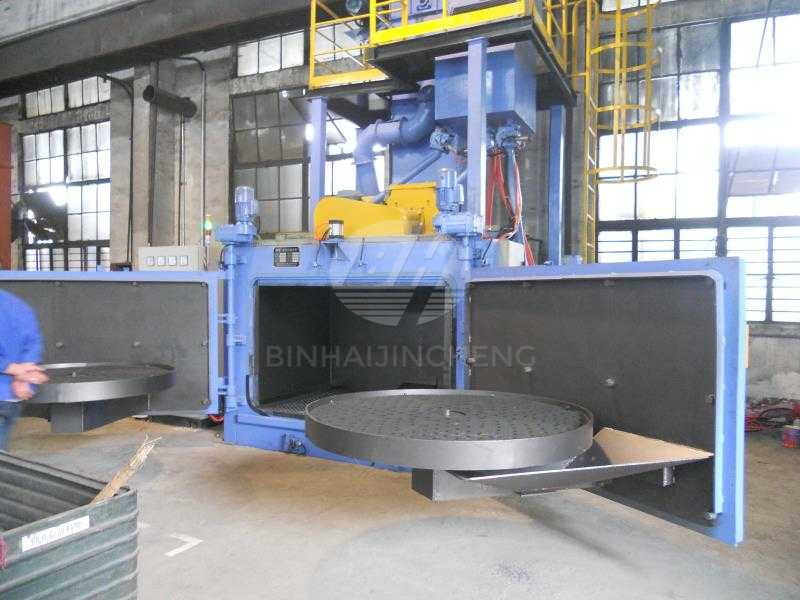
Q35 Series Turn Table type Shot Blasting Machine
Summary
Q35 Series Turn Table type Shot Blasting Machine is suitable for surface treatment of small batch castings, forgings and heat treatment parts. Also can strengthen the surface of work-pieces according to the requirements of customers. Especially suitable for the surface cleaning of the work-piece which has the feature of flat; thin wall and fear collision.
Q35M Series 2 stations Turn Table type Shot Blasting Machine is Q35 Series upgraded products.
(Q35M) The turntable is installed on the revolving door with bearing. With the opening of the door, the turntable will turn out. It is very convenient to take and place the work-piece.
Generally applicable to the work-pieces with cleaning requirements only for one side (flat parts). -
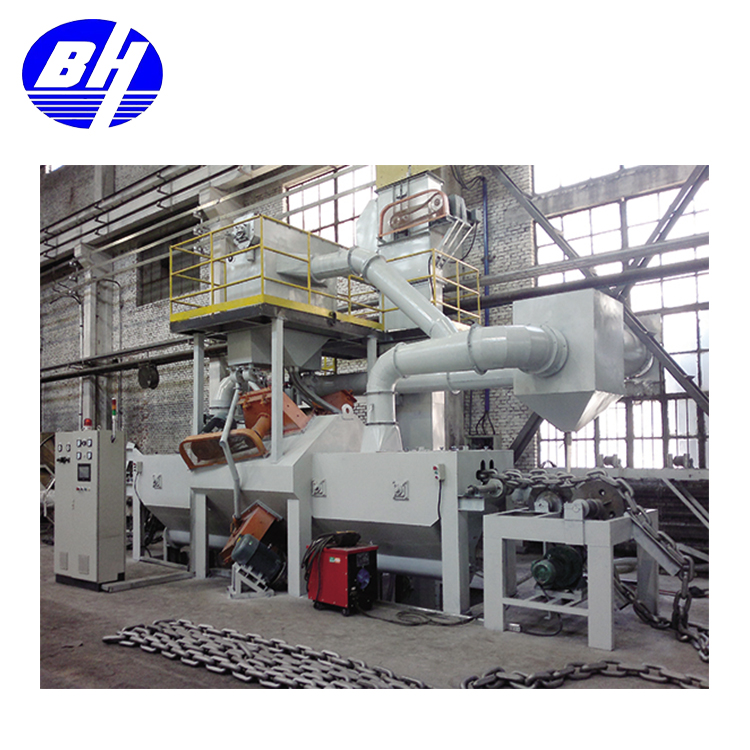
QM Series Anchor Chain Shot Blasting Machine
Summary
QM Series Anchor Chain Shot Blasting Machine is a special type shot blasting cleaning equipment for Anchor Chain. After shot blasting by this machine, it will remove the oxides and attachments on the surface of the anchor chain, And by the causing plastic deformation on its surface, effectively improve the fatigue strength and corrosion resistance of anchor chain.Greatly increases the adhesion of the paint film. -
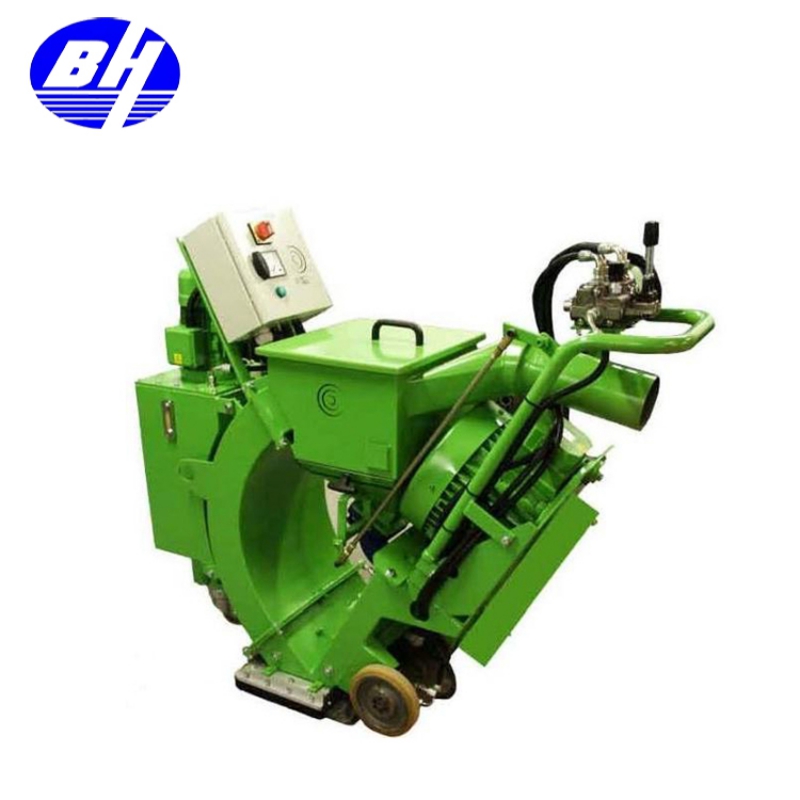
Mobile type Shot Blasting Machine for Paves
Summary
The Floor shot blasting machine is the shot blasting machine ejects the shot material (steel shot or sand) at a high speed and a certain angle onto the working surface through a mechanical method.
The shot material fully impacts the working surface to achieve the rough surface and remove residues. At the same time, the negative pressure generated by the dust collector will clean the pellets and the cleaned impurity dust etc. after the airflow, the intact pellets will be automatically recycled, and the impurities and dust will fall into the dust collection box. -
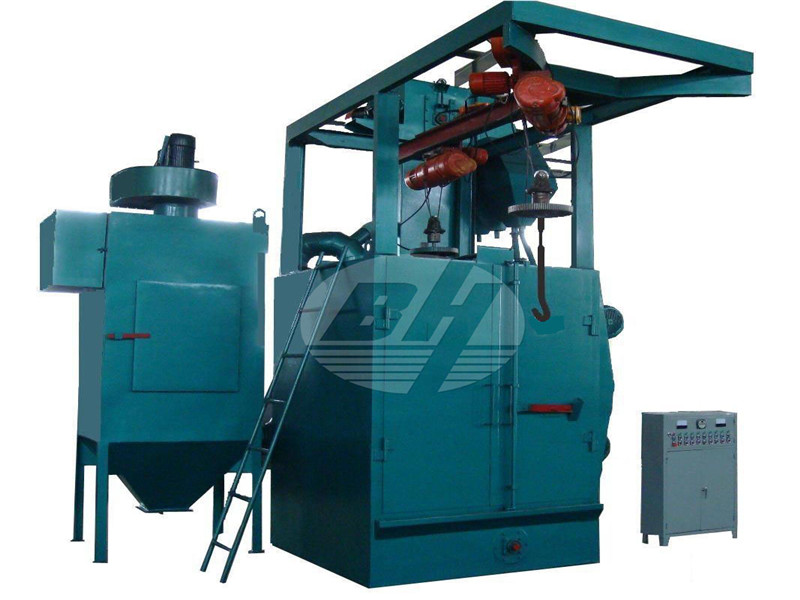
Hook Type Shot Blasting Machine
Machine Usage: Hook type shot blasting machine is suitable for cleaning the foundry part, construction, chemical engineering, machine tools and many other industries of large, medium size castings and forgings surface cleaning.it is the most popular type cleaning machine. We apply this cleaning technology to achieve the purpose of derusting, strengthen Eliminate internal stress Improve surface adhesion Descaling improve the fatigue resistance Prolong its service life Before cleaning Afte... -
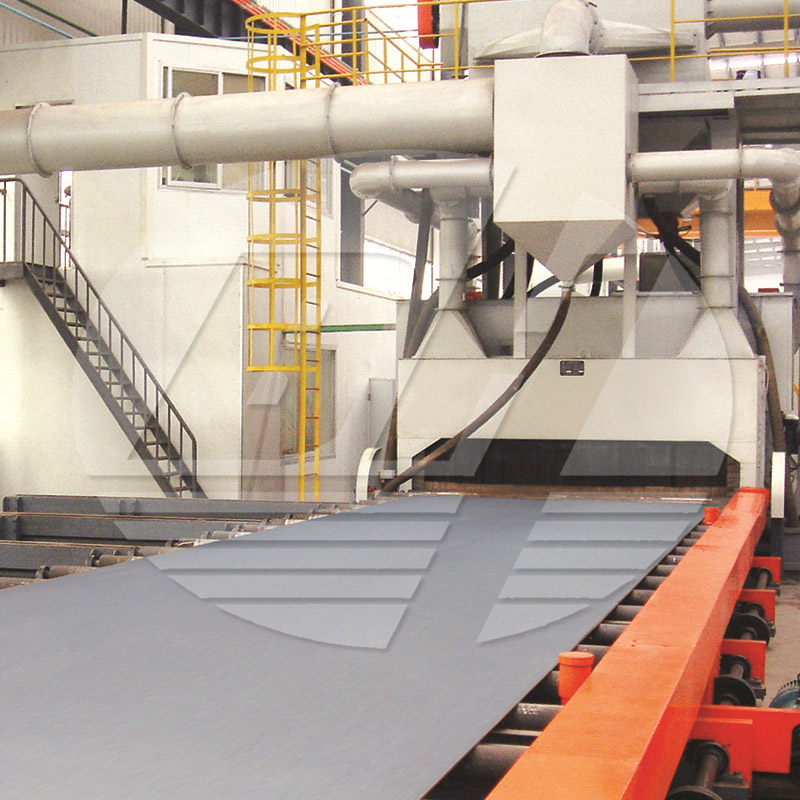
Steel Plate Shot Blasting Machine
Steel Plate Shot Blasting Machine strongly blast the sheet metal and profiles to remove surface rust, welding slag and scale, making it slow uniform metal color, improve coating quality and corrosion prevention effect. Its processing range from 1000mm to 4500mm, and it can easily integrated intro preservation lines for automatic painting.
-

Shot blasting machine for Steel track with large specification
Product Description This crawler type shot blasting machine is one of the standard series of cleaning equipment. It can be used to clean casting, forging and welding parts, and remove the sand and oxide scale on the surface of the workpiece. Due to the good protective measures of the machine, the good performance of the shot blasting machine, and the reasonable structure of the projectile circulation system, satisfactory results can also be obtained for materials and workpieces that are diffi...
